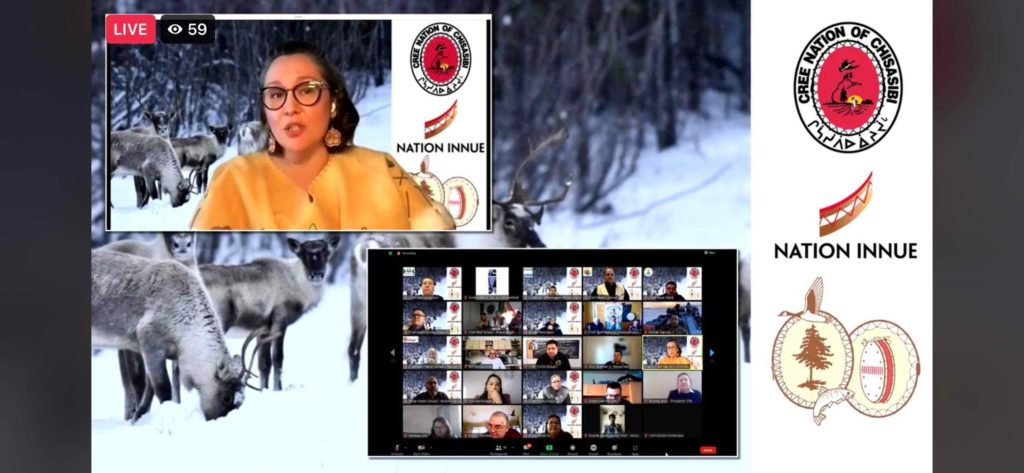On January 24, Cree and Innu leaders signed a Traditional Mutual Understanding – the Maamuu nisituhtimuwin/ Matinueu-mashinaikan atiku e uauinakanit – that allows authorized Innu hunters to harvest up to 300 caribou this winter on Cree territory east of Chisasibi.
As both nations have long survived scarcity by following caribou trails in overlapping territory, in 2019 Innu Elders formally asked the Cree for help in preserving the caribou harvest.
“For us, this community hunt will not only meet a need for our Elders’ food security, but also perpetuate a sharing relationship that dates back to time immemorial,” said Mike McKenzie, Chief of Uashat Mak Mani-utenam and the spokesperson for nine Innu communities.
The agreement is based on principles of sharing, sustainable harvesting and respect for the animal. The agreed-upon protocols – developed during long discussions with Cree Elders – reinforce the role of the tallymen as stewards of the land while ensuring the safety of individuals.
“This Understanding between two nations would not be possible without the input of the community’s tallymen through their openness, understanding and willingness to work with the Innu Nation,” said Grand Chief Mandy Gull-Masty. “Returning to this traditional relationship is a form of decolonization but it also indicates that Indigenous people have the ability to lead conservation and preservation measures.”
While the Leaf River herd’s population in Chisasibi territory has stabilized at approximately 190,000, caribou numbers overall have declined sharply over the last 20 years. The George River herd has recovered slightly to about 8,100 – a number which is still only 1% of its peak in the early 1990s.
Several Indigenous nations came together in 2013 to develop a management strategy through the Ungava Peninsula Caribou Aboriginal Round Table (UPCART). After this agreement was signed in 2017, Quebec finally announced a moratorium on sport hunting.
“I really battled with Quebec about the wastage and security concerns that trappers had expressed,” said Cree-Quebec governance coordinator Nadia Saganash. “It prevented people from going into the territory because they were afraid for their security. There were high-powered firearms, bullets going into cabins. When the sports hunt finally closed, it was a victory for us.”
While the disrespectful practices of sports hunters were a source of outrage, land users also recognized the need for common harvest limits. This became apparent after an Innu community hunt harvested about 280 caribou last winter without notifying tallymen.

The Understanding specifies that hunting activities require a letter of consent from local authorities accepted by both the Cree and Innu nations. It emphasizes the use of all parts of harvested animals with no wastage. Prolonged chases are proscribed, and harvests shall only be made for cultural and sustenance needs, not monetary profit.
“There’s a process in place that has to be followed,” Gull-Masty told the Nation. “There’s a selection of dates and areas identified where they can go, they have to have a member of the trapline accompanying them, report to us what they harvested and follow all safety protocols. I hope it will be clear to everybody this doesn’t mean just show up and hunt.”
In coming weeks, each Innu community will identify a hunting group to harvest their agreed-upon allocation, arriving one after another in coordination with the local Cree Trappers’ Association and concerned tallymen. Quebec has been informed to prevent interventions by wildlife officials. Above all, however, Gull-Masty’s priority is to build healthy relationships with other First Nations.
“We have longstanding overlap issues with the Innu Nation,” said Gull-Masty. “I’m excited we’re already starting to see what kinds of cultural exchanges we can organize with our youth. We’re talking with the Naskapi and Inuit communities as well. I think you’ll see similar announcements like this one concerning a number of topics.”
Recognizing that the Leaf River herd remains vulnerable, it was determined that 300 caribou would be “gifted” to the Innu Nation out of the guaranteed Cree harvest of 850 stipulated in the James Bay and Northern Quebec Agreement. Chisasibi Chief Daisy House said the process will be reviewed in March “when they start calving and little caribou come around.”
Guides designated by each trapline will ensure safety, particularly near bodies of water that can be dangerous. Both sides agreed not to hunt at night or from moving snowmobiles – nor to post their harvests on social media.
“That’s how we came up with ‘understanding’, Maamuu nisituhtimuwin,” House told the Nation. “Our ancestors hunted together with the Innu. In one of the discussions, they said of course we’re going to say yes. That’s our custom – we help those in need. They need to eat; they want to practice their traditions.”
Chisasibi Elders and other land users were instrumental in developing the Understanding, as Nadia Saganash and Tina Petawabano directly translated their words with the help of legal counsel.
“That’s true consultation – making a document out of the words of these land users and tallymen,” House asserted. “We always heard teachings. It was as if we were there. It was real, special. I hope someday the stories are recorded because they are amazing – all you can do is imagine.”
While results of an aerial survey planned this summer could modify next year’s harvest, all participants are proud of this “historic event”.
“What really stood out for me was the meeting on December 16 with the Innu Chiefs and our local CTA,” recalled House. “How excited and happy the Elders were that this was finally coming to fruition. They were so eager. That was icing on the cake.”
by Patrick Quinn, Local Journalism Initiative Reporter





